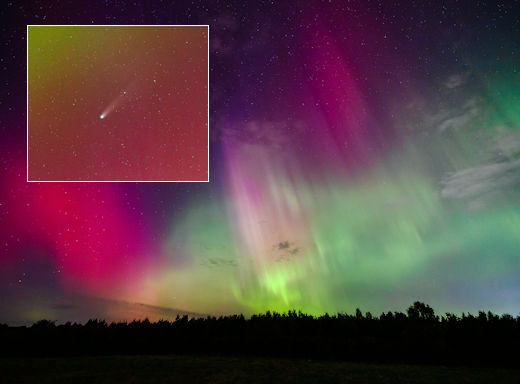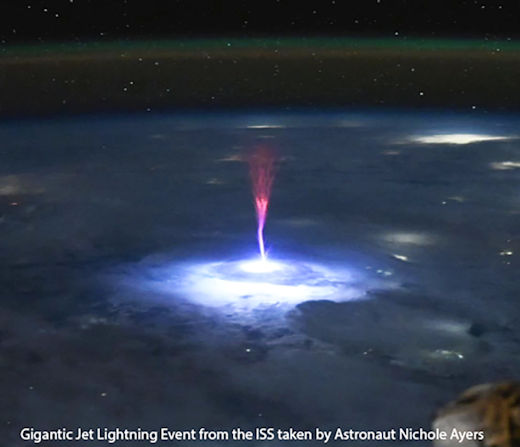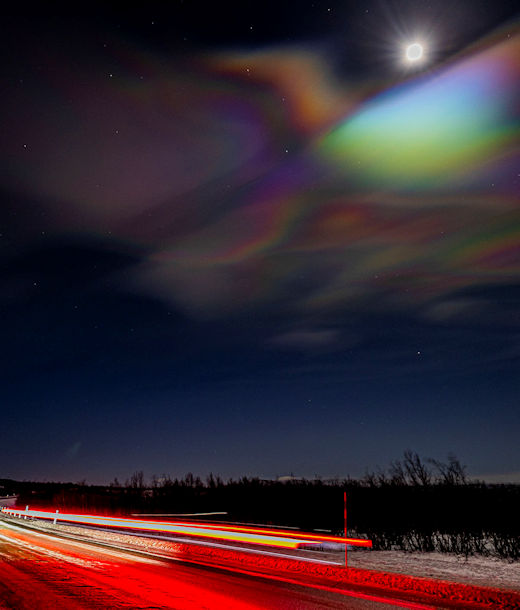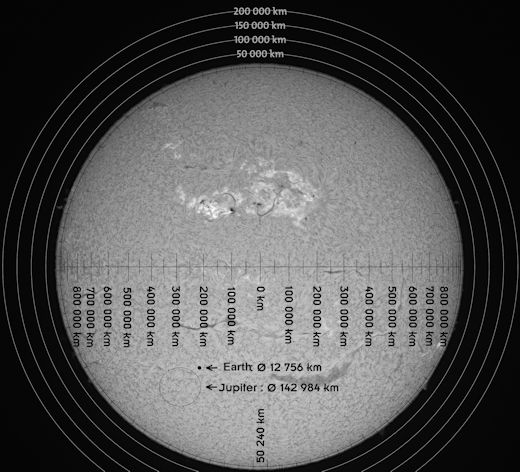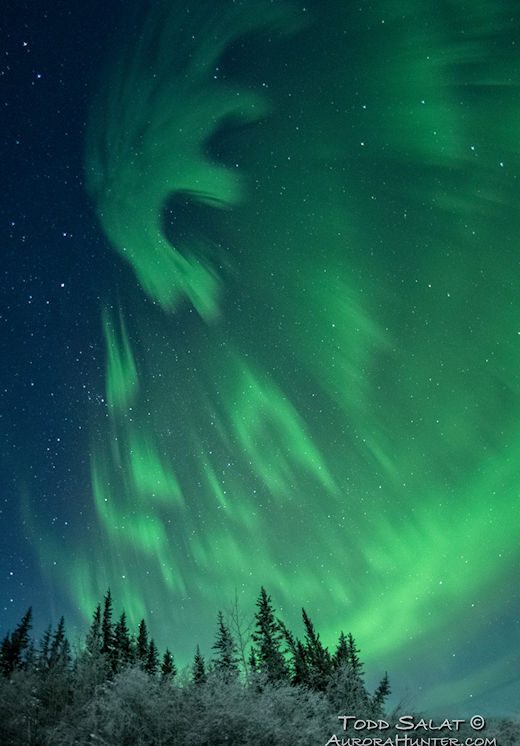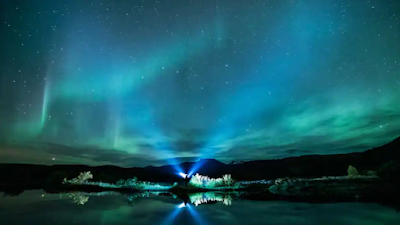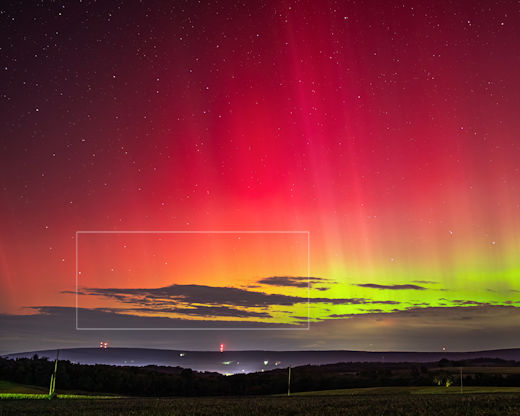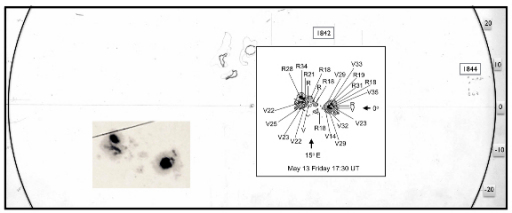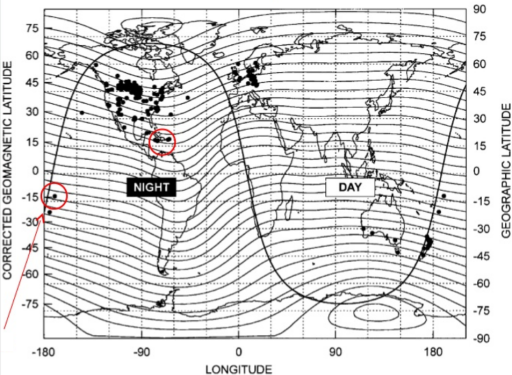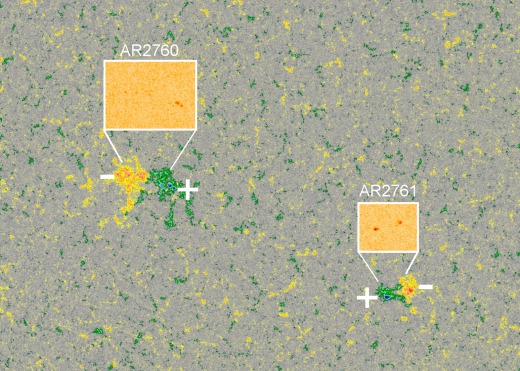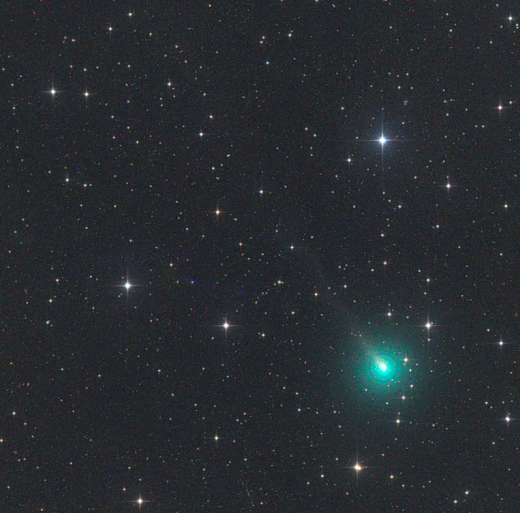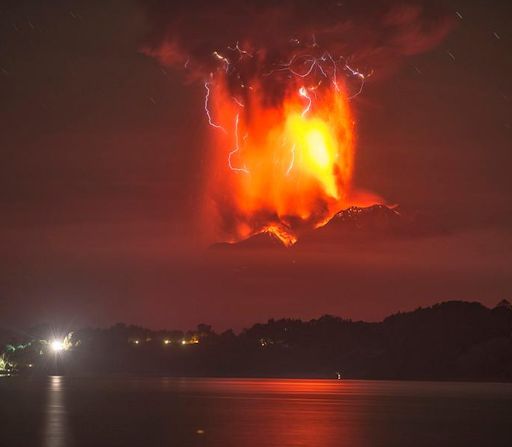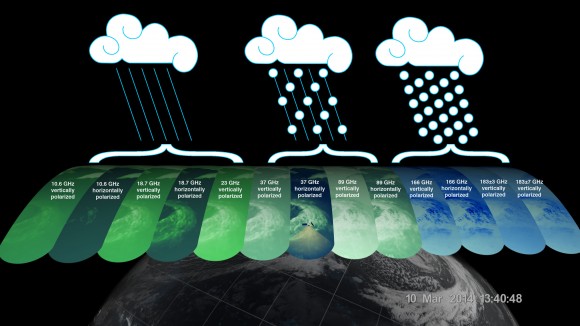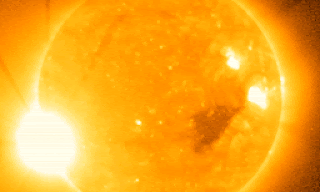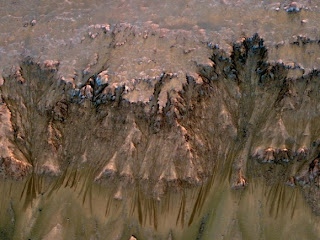20th October 2025
COMET LEMMON AND THE GEOMAGNETIC STORM: An overdue CME passed near Earth during the late hours of Oct. 17th. The near-miss produced an unexpected photo-op. Auroras swallowed Comet Lemmon (C/2025 A6):
Alan C. Tough captured the event from Elgin, Moray, Scotland. "I set up a star tracker with a DSLR and 150mm lens in my back garden to photograph Comet Lemmon when the auroras erupted," he says.
The CME was expected to reach Earth two days earlier. Better late than never. It sparked a G1/G2-class storm with auroras sighted in the USA as far south as New York and Utah.
In the Czech Republic, Petr Horálek observed the effect of the solar wind on the comet itself:
"This was a truly unusual view," Horálek says. "During the storm, the comet over Seč Lake was surrounded by red auroras. When I zoomed in on the comet, I could see its ion tail was twisted by the buffeting of the solar wind."
The storm is over, but the comet is still there. In fact, it's about to make its closest approach to Earth, only 0.6 AU away on Oct. 21st. Shining at 4th magnitude, it will be visible to the naked eye and even cell phones (with night-sky photo settings) should be able to catch it. Point your optics low in the northwestern sky after sunset.
8th July 2025
'SPACE LIGHTNING' PHOTOGRAPHED FROM THE ISS:
On July 3, 2025, astronaut Nichole Ayers aboard the International Space Station captured a rare and breathtaking image: a Gigantic Jet bursting upward from a thunderstorm in North America. The high-resolution photograph shows a crimson bolt arcing from the cloudtops toward the edge of space.
"Just. Wow," Ayers posted after the event. "As we went over Mexico and the U.S. this morning, I caught this [Gigantic Jet] triggered by intense electrical activity in the thunderstorms below."
József Bór, an atmospheric scientist at the Institute of Earth Physics and Space Science in Hungary, was thrilled by the image. "Nichole's photo sets a new standard for space-borne observations of Gigantic Jets," he says. "Such a sharply focused and detailed photo of a Gigantic Jet has never been recorded from space."
Most readers have heard of sprites, and maybe even seen one or two on a stormy summer night. They emerge from the tops of intense thunderstorms like upside-down lightning, reaching their eerie red tendrils toward space.
Gigantic jets like sprites on steroids--visually more impressive and far more rare. While sprites were discovered in 1989 and have since been photographed by the thousands, it was not until 2001-2002 that Gigantic Jets were first recorded from Puerto Rico and Taiwan. No more than a few dozen have ever been photographed with a quality approaching that of Ayers' image.
Ayers's photo is now one of the best ever taken of a Gigantic Jet
13th February 2025
POLAR STRATOSPHERIC CLOUDS AT NIGHT: Unusual weather in the stratosphere has set the stage for a rare nighttime apparition of polar stratospheric clouds (PSCs). Marianne Bergli photographed the display last night in Kilpisjervi, Finland:
"The PSCs were even more colorful than auroras," says Bergli. "The full Moon lit them beautifully."
This is rare. Normally, Earth's stratosphere has no clouds at all. Only when the temperature drops to a staggeringly-low -85 C can widely-spaced water molecules assemble into icy Type II PSCs. During a typical polar winter, sky watchers might see them no more than once or twice, almost always during the day when bright sunlight causes their colors to blossom.
Nighttime displays are doubly rare because the clouds must coincide with a bright Moon to make them visible in full color. Tonight is such a night!
"The PSCs were truly amazing," he says. "Since mid-January 2025, I have seen these colorful clouds weekly or every second week."
According to NASA's MERRA2 climate model, the polar stratosphere has been exceptionally cold this winter with temperatures dropping to near 45-year lows. The reason might be the stratospheric polar vortex. This winter's vortex has been strong, keeping cold air bottled up over the Arctic Circle.
Springtime dynamics could soon upset that cold air mass. Until then, Arctic sky watchers should remain alert for PSCs--even at night. They're the most beautiful clouds on Earth.
3rd February 2025
THE SCALE OF A GIANT SUNSPOT COMPLEX:
"Giant" is the right word. Sunspot complex 3976-82 contains more than 3 dozen dark cores scattered across more than 500,000 km of the sun's surface. David Strange of East Devon UK wrapped a ruler around the sun to illustrate the awesome scale of the active region:
Strange took the picture earlier today using an H-alpha telescope tuned to the red glow of solar hydrogen. It shows an area of magnetic turmoil twice as wide as the planet Jupiter, so large that Earth itself is a speck in comparison. Super flare-y sunspot 3981 is just one of five sunspot groups contained within its boundary.
As the sun slowly turns, parts of this complex will remain Earth-directed for the rest of the week.
November 26th ..2024
"I saw these bizarre auroras drift over southcentral Alaska around 4 am last Friday morning," says Salat. "It came up from the northwest and I was like, whoa! It looked like the letter E to me."
Salat may have witnessed an episode of 'black auroras.' They are dark rings or black blobs that sometimes appear in an otherwise ordinary expanse of auroral light. For example, look at Figure 1 in this research paper on the topic. Some researchers call them "anti-auroras." The black auroras in Salat's photo are circled here.
10-11 October 2024
Auroras sighted in Leh: How a solar storm led to this rare phenomena
A severe geomagnetic storm hit the earth on Thursday, creating celestial lightshows farther south than usual
Solar activity follows an 11-year cycle, peaking at the solar maximum, which is expected in 2025. As we approach this peak, experts predict more frequent and intense solar storms, which may bring about more aurora sightings, even in regions not typically prone to them.
Courtesy Zee News
(Picture source - X/IIAstrophysics)
12th August 2024:
AURORAS SHOULD NOT BE ORANGE (BUT THEY ARE):
During last week's severe (G4-class) geomagnetic storm, Tony Bendele of Pennsylvania saw something rare and a little mysterious. "Orange auroras!" he says. "Yes, Orange. I had never seen this color in auroras before." Note the boxed hue in Bendele's Aug 12th photo:
What's so mysterious? There's no element in Earth's atmosphere capable of making bright orange. It's simple chemistry. Every aurora color has a matching atom or molecule. For instance, oxygen atoms produce red and green. Nitrogen molecules give us purple and, sometimes, pink. Theoretically, N2, N2+, and O2+ can produce emissions at orange wavelengths. However, these emissions are very weak compared to other colors produced by the same molecules. Auroras should not be orange.
"Mars is experiencing its greatest level of auroral activity in the past 10 years," says Nick Schneider of the University of Colorado's Laboratory for Atmospheric and Space Physics (LASP).
Orbiting high above Mars, NASA's MAVEN spacecraft recorded the auroras on 3-4 Feb, 7-10 Feb and 15-16 Feb. This animation shows the last two of these episodes in a looping time series:
Here on Earth we would love it if auroras were global. Seeing Northern Lights with equal ease from the equator and the poles would check off a lot of bucket lists. Be careful what you wish for, though. Martian auroras can be global because the Red Planet has almost no protection from solar storms. It lacks an Earth-like magnetic field, so particles from the sun penetrate its atmosphere with ease--everywhere.
The dramatic auroras of February 2024 were caused by "SEPs"--solar energetic particles. SEPs are accelerated by shock waves within approaching CMEs. When they strike Mars's atmosphere, they cause it to glow.
|
|
|
The forecast comes from the Solar Cycle Prediction Panel representing NOAA, NASA and the International Space Environmental Services (ISES). This amounts to the ‘official’ forecast for the solar cycle. The Prediction Panel forecasts the sunspot number expected for solar maximum and has predicted Cycle 25 to reach a maximum of 115 occurring in July, 2025. The error bars on this prediction mean the panel expects the cycle maximum could be between 105-125 with the peak occurring between November 2024 and March 2026.
28th April 2020
24th April 2020
23rd April 2020
SOLAR MINIMUM CONDITIONS ARE IN EFFECT: The sun has been blank (without sunspots) for 18 consecutive days. This is a sign that Solar Minimum is underway. The sun is passing through the nadir of the 11-year solar cycle, a slow process that could continue for much of 2020
Daily Sun: 23 Apr 20
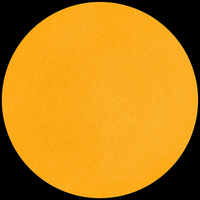
Updated 23 Apr 2020Spotless DaysCurrent Stretch: 18 days
2020 total: 88 days (77%)
2019 total: 281 days (77%)
2018 total: 221 days (61%)
2017 total: 104 days (28%)
2016 total: 32 days (9%)
2015 total: 0 days (0%)
2014 total: 1 day (<1%)
2013 total: 0 days (0%)
20th April 2020
For the first time, SpaceX's controversial Starlink satellites have been photographed by astronauts onboard the International Space Station. Here they are, photobombing a display of aurora australis on April 13, 2020
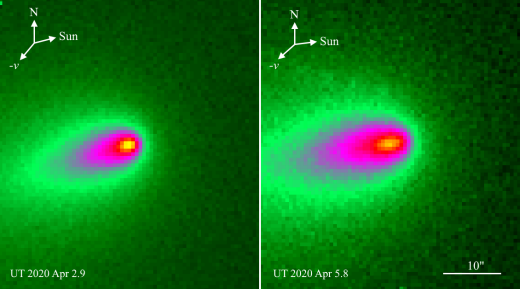 Images from the 0.6-m Ningbo Education Xinjiang Telescope show a possible fragmentation of ATLAS's core
Images from the 0.6-m Ningbo Education Xinjiang Telescope show a possible fragmentation of ATLAS's core3rd April 2020
Posted 15th March 2017:
Daily Sun: 15 Mar 17
The sun is blank--no sunspots. Credit: SDO/HMI
Sunspot number: 0
Updated 15 Mar 2017
Spotless Days
Current Stretch: 9 days
2017 total: 20 days (27%)
2016 total: 32 days (9%)
2015 total: 0 days (0%)
2014 total: 1 day (<1%)
2013 total: 0 days (0%)
2012 total: 0 days (0%)
2011 total: 2 days (<1%)
2010 total: 51 days (14%)
2009 total: 260 days (71%)
-------------------------------------------------------------------------------
Night Life in Antartica...
You'd think extreme cold in the dead of winter would keep Antarctic researchers inside. The staff of the Bharati Indian Base Station in Antarctica's Larsemann hills are an exception: "We can't stay inside," reports B. Sudarsan Patro. "The night life is just too amazing!"
Patro took this group self portrait on June 30th during a brilliant outburst of auroras. "They were so bright," he says, "the snow turned green. The sparkling display reminded us of Diwali, the Hindu festival of lights."
This display shows that bright auroras can occur even when solar activity is very low. There were no sunspots, no solar flares, and no CMEs on June 30th, yet skies turned green anyway. Probably what happened is this: Earth passed through a region of space filled with negative-polarity magnetic fields
-------------------------------------------------------------------------
Series on Atmospheres of the Planets of our Solar System...( Courtesy Universe Today)
Nature and the Universe has Blessed our beautiful Planet's Atmosphere as the most conducive and protective for us Humans..If only we can preserve and maintain it !
Nature does not need us, We need Nature !
C) :Mercury's Atmosphere:
Mercury is too hot and too small to retain an atmosphere. However, it does have a tenuous and variable exosphere that is made up of hydrogen, helium, oxygen, sodium, calcium, potassium and water vapor, with a combined pressure level of about 10-14 bar (one-quadrillionth of Earth’s atmospheric pressure). It is believed this exosphere was formed from particles captured from the Sun, volcanic outgassing and debris kicked into orbit by micrometeorite impacts.Because it lacks a viable atmosphere, Mercury has no way to retain the heat from the Sun. As a result of this and its high eccentricity, the planet experiences considerable variations in temperature. Whereas the side that faces the Sun can reach temperatures of up to 700 K (427° C), while the side in shadow dips down to 100 K (-173° C).B): Venus' Atmosphere...How does the atmosphere of the Hottest Planet in our Solar System compare with ours ...Venus being our Neighbour.
Surface observations of Venus have been difficult in the past, due to its extremely dense atmosphere, which is composed primarily of carbon dioxide with a small amount of nitrogen. At 92 bar (9.2 MPa), the atmospheric mass is 93 times that of Earth’s atmosphere and the pressure at the planet’s surface is about 92 times that at Earth’s surface.
Venus is also the hottest planet in our Solar System, with a mean surface temperature of 735 K (462 °C/863.6 °F). This is due to the CO²-rich atmosphere which, along with thick clouds of sulfur dioxide, generates the strongest greenhouse effect in the Solar System. Above the dense CO² layer, thick clouds consisting mainly of sulfur dioxide and sulfuric acid droplets scatter about 90% of the sunlight back into space.
Another common phenomena is Venus’ strong winds, which reach speeds of up to 85 m/s (300 km/h; 186.4 mph) at the cloud tops and circle the planet every four to five Earth days. At this speed, these winds move up to 60 times the speed of the planet’s rotation, whereas Earth’s fastest winds are only 10-20% of the planet’s rotational speed.
Venus flybys have also indicated that its dense clouds are capable of producing lightning, much like the clouds on Earth. Their intermittent appearance indicates a pattern associated with weather activity, and the lightning rate is at least half of that on Earth.
A): The Earth's Atmosphere..How much do you know of it...How many "spheres are there ? What is the individual break up ? What is the famous Ozone Layer ?..
Earth's Atmosphere:
Earth's atmosphere, which is composed of nitrogen, oxygen, water vapor, carbon dioxide and other trace gases, also consists of five layers.
These consists of the Troposphere, the Stratosphere, the Mesosphere, the Thermosphere, and the Exosphere. As a rule, air pressure and density decrease the higher one goes into the atmosphere and the farther one is from the surface.Closest to the Earth is the Troposphere, which extends from the 0 to between 12 km and 17 km (0 to 7 and 10.56 mi) above the surface. This layer contains roughly 80% of the mass of Earth's atmosphere, and nearly all atmospheric water vapor or moisture is found in here as well. As a result, it is the layer where most of Earth's weather takes place.
The Stratosphere extends from the Troposphere to an altitude of 50 km (31 mi). This layer extends from the top of the troposphere to the stratopause, which is at an altitude of about 50 to 55 km (31 to 34 mi). This layer of the atmosphere is home to the ozone layer, which is the part of Earth's atmosphere that contains relatively high concentrations of ozone gas.
Next is the Mesosphere, which extends from a distance of 50 to 80 km (31 to 50 mi) above sea level. It is the coldest place on Earth and has an average temperature of around -85 °C (-120 °F; 190 K).
The Thermosphere, the second highest layer of the atmosphere, extends from an altitude of about 80 km (50 mi) up to the thermopause, which is at an altitude of 500–1000 km (310–620 mi).The lower part of the thermosphere, from 80 to 550 kilometers (50 to 342 mi), contains the ionosphere - which is so named because it is here in the atmosphere that particles are ionized by solar radiation. This layer is completely cloudless and free of water vapor. It is also at this altitude that the phenomena known as Aurora Borealis and Aurara Australis are known to take place.
The Exosphere, which is outermost layer of the Earth's atmosphere, extends from the exobase - located at the top of the thermosphere at an altitude of about 700 km above sea level - to about 10,000 km (6,200 mi). The exosphere merges with the emptiness of outer space, and is mainly composed of extremely low densities of hydrogen, helium and several heavier molecules including nitrogen, oxygen and carbon dioxideThe exosphere is located too far above Earth for any meteorological phenomena to be possible. However, the Aurora Borealis and Aurora Australis sometimes occur in the lower part of the exosphere, where they overlap into the thermosphere.
The average surface temperature on Earth is approximately 14°C; but as already noted, this varies. For instance, the hottest temperature ever recorded on Earth was 70.7°C (159°F), which was taken in the Lut Desert of Iran. Meanwhile, the coldest temperature ever recorded on Earth was measured at the Soviet Vostok Station on the Antarctic Plateau, reaching an historic low of -89.2°C (-129°F).
From Universe Today
---------------------------------------------------------------------------------------------------------------------------------------------------------------------------------------------------------------------------------------------------
Posted 9th September 2015:
The Moon, just a couple days before new phase and the upcoming partial solar eclipse, joins Venus and Mars in the dawn sky on Thursday Sept. 10. Well below the triplet, look for returning Jupiter.But if you get up early and look east, you’ll discover where the party is. Venus, Mars and now Jupiter
Source: Stellarium
Posted 28th August:
RARE GIGANTIC JETS ABOVE HURRICANE HILDA:
On 12th/13th August, a rare apparition of sprites above Hurricane Hilda was reported and shot.
Steve Cullen, who lives in Hawaii where the storm is heading, spotted them in video from the Canada-France-Hawaii Telescope CloudCam atop Maunakea. A closer look at the video, however, reveals that the dancing forms were not sprites.
See the Video here
Instead, Hurricane Hilda has gigantic jets:
Gigantic jets are lightning-like discharges that spring from the tops of thunderstorms, reaching all the way from the thunderhead to the ionosphere more than 50 miles overhead. They're enormous and powerful.
"Gigantic jets are much more rare than sprites," says Oscar van der Velde, a member of the Lightning Research Group at the Universitat Politècnica de Catalunya. "While sprites were discovered in 1989 and have since been photographed by the thousands, it was not until 2001-2002 that gigantic jets were first recorded from Puerto Rico and Taiwan." Only a few dozen gigantic jets have ever been seen, mostly over open ocean.
Gigantic jets, and their cousins the sprites, reach all the way up to the edge of space alongside meteors, noctilucent clouds, and some auroras. This means they are a true space weather phenomenon. Indeed, some researchers believe cosmic rays help trigger these exotic forms of lightning, but the link is controversial.
Reprint from Spaceweather.
-----------------------------------------------------------------------------------------------------------------------------------------------------------------------------------------------------------------------------------------------------
Posted 18th August 2015...
Indian Mars Orbiter Shoots Spectacular New Images of Sheer Canyon and Curiosity’s Crater...
by Ken Kremer
The Indian Space Research Organization (ISRO) has published a beautiful gallery of images featuring a steep and stunning Martian canyon and the landing site of NASA’s Curiosity Mars Science Laboratory rover.
This view over the Ophir Chasma canyon on the Martian surface was taken by the Mars Colour Camera aboard India’s Mars Orbiter Mission (MOM). Ophir Chasma is a canyon in the Coprates quadrangle located at 4° south latitude and 72.5° west longitude. It is part of the Valles Marineris canyon system. Credit: ISRO
This view over the Ophir Chasma canyon on the Martian surface was taken by the Mars Colour Camera aboard India’s Mars Orbiter Mission (MOM). Ophir Chasma is a canyon in the Coprates quadrangle located at 4° south latitude and 72.5° west longitude. It is part of the Valles Marineris canyon system. Credit: ISRO
Here’s an illuminating and magnificent 3D portrayal of Ophir Chasma created by Indian scientists that gives a sense of the canyons scale, sheer walls and cliffs and depth:
3D portrayals of Ophir Chasma terrain based on images taken by India’s Mars Orbiter Mission color camera on 19 July 2015 . Credit: ISRO
ISRO also released a delightful new image of Gale Crater and the surrounding vicinity.
Gale Crater is the landing site of NASA’s Curiosity rover. MOM took the image from an altitude of 9004 kilometers. Gale Crater is home to humongous Mount Sharp, a mountain that rises 5.5 kilometers (3.4 miles) from the crater floor and is easily visible in the photo from MOM. The crater is 154 kilometers (96 mi) wide.
Read More details on this here
-------------------------------------------------------------------------------------------------------------------------------
Posted 30th June 2015..
You have got to see this. Venus and Jupiter are having a spectacular close encounter in the sunset sky.
Just step outside after sunset and face west. Venus and Jupiter are less than a degree apart. Don't wait until the sky fades to black. A tight conjunction of Venus and Jupiter framed by twilight blue has a special beauty that you won't want to miss.
The night of closest approach is June 30th, when Venus and Jupiter will be only 1/3rd of a degree apart. If you have binoculars or a small telescope, point them at the planets. Both will fit in the same field of view, allowing you to see the fat crescent phase of Venus and the moons of Jupiter simultaneously. It's a great way to end the day.
From Spaceweather.com
------------------------------------------------------------------------------------------------------------------------------
Posted 1st May 2015
Watch an Enormous “Plasma Snake” Erupt from the Sun
by JASON MAJOR
SOHO LASCO C2 (top) and SDO AIA 304 (bottom) image of a solar filament detaching on April 28-29, 2015
Over the course of April 28–29 a gigantic filament, briefly suspended above the surface* of the Sun, broke off and created an enormous snakelike eruption of plasma that extended millions of miles out into space.
The event was both powerful and beautiful, another demonstration of the incredible energy and activity of our home star…and it was all captured on camera by two of our finest Sun-watching spacecraft.
Made from data acquired by both NASA’s Solar Dynamics Observatory (SDO) and the joint ESA/NASA SOHO spacecraft, the video was compiled by astronomer and sungrazing comet specialist Karl Battams. It shows views of the huge filament before and after detaching from the Sun, and gives a sense of the enormous scale of the event.
At one point the plasma eruption spanned a distance over 33 times farther than the Moon is from Earth!
Watch a video of the event here....
from Universe today..
Posted 24th April 2015
Stunning Photo of Volcanic Lightning at Volcán de Colima in Mexico...

Courtesy Universe Today
Very Interesting development for Meteorology...Must Read...
NASA’s RapidScat Ocean Wind Watcher Starts Earth Science Operations at Space Station... Read here
Cloud Streets over the Black Sea
The Moderate Resolution Imaging Spectroradiometer (MODIS) on the Aqua satellite captured this image of cloud streets over the Black Sea on January 8, 2015.
Cloud streets are long parallel bands of cumulus clouds that form when cold air blows over warmer waters and a warmer air layer (temperature inversion) rests over the top of both. The comparatively warm water gives up heat and moisture to the cold air above, and columns of heated air called thermals naturally rise through the atmosphere. The temperature inversion acts like a lid. When the rising thermals hit it, they roll over and loop back on themselves, creating parallel cylinders of rotating air. As this happens, the moisture cools and condenses into flat-bottomed, fluffy-topped cumulus clouds that line up parallel to the direction of the prevailing winds.
NASA Earth Observatory image courtesy Jeff Schmaltz LANCE/EOSDIS MODIS Rapid Response Team, GSFC. Caption by Adam Voiland.
Instrument(s):
Aqua - MODIS
Fantastically Colorful Clouds Spotted in Arctic Stratosphere
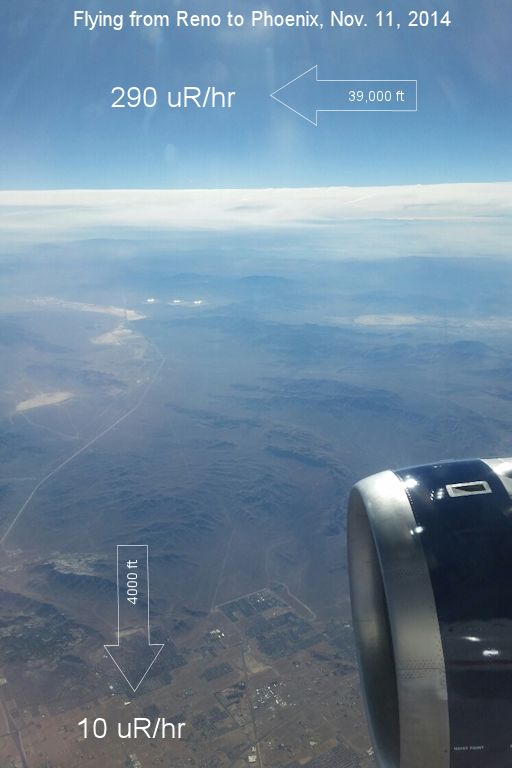
"The comet is presently moving against the dense star clouds of the southern Milky Way," says Peach. "Soon, however, it will reach Mars."
That's good, because when the comet arrives, the atmosphere of the comet will likely brush against the atmosphere of Mars, possibly sparking auroras on the Red Planet. MAVEN could record these alien lights. (Universe Today)
Animation of Pluto and Charon showing nearly a full rotation (NASA/Johns Hopkins University Applied Physics Laboratory/Southwest Research Institute)
Now here’s something I guarantee you’ve never seen before: a video of the dwarf planet Pluto and its largest moon Charon showing the two distinctly separate worlds actually in motion around each other! Captured by the steadily-approaching New Horizons spacecraft from July 19–24, the 12 images that comprise this animation were acquired with the Long Range Reconnaissance Imager (LORRI) instrument from distances of 267 million to 262 million miles (429 million to 422 million km) and show nearly a full orbital rotation. Absolutely beautiful!
Pluto and Charon are seen circling a central gravitational point known as the barycenter, which accounts for the wobbling motion. Since Charon is 1/12th the mass of Pluto the center of mass between the two actually lies a bit outside Pluto’s radius, making their little gravitational “dance” readily apparent.
(The same effect happens with the Earth and Moon too, but since the barycenter lies 1,700 km below Earth’s surface it’s not nearly as obvious.)
Launched January 19, 2006, New Horizons is now in the final year of its journey to the Pluto system.
The primary mission includes five “deep-dip” campaigns, in which MAVEN’s periapsis, or lowest orbit altitude, will be lowered from 93 miles (150 kilometers) to about 77 miles (125 kilometers). These measurements will provide information down to where the upper and lower atmospheres meet, giving scientists a full profile of the upper tier.
India's MOM ( Mangalyan) follows. Expected to enter Mars' orbit on 24th September...
By the time you finish reading this story, you'll be about 1,000 km closer to the planet Mars.
Earth and Mars are converging for a close encounter. As March gives way to April, the distance between the two planets is shrinking by about 300 km every minute. When the convergence ends in mid-April, the gulf between Earth and Mars will have narrowed to only 92 million km--a small number on the vast scale of the solar system.
Astronomers call this event an "opposition of Mars" because Mars and the Sun are on opposite sides of the sky. Mars rises in the east at sunset, and soars almost overhead at midnight, shining burnt-orange almost 10 times brighter than a 1st magnitude star.
There are two dates of special significance:
April 8th is the date of opposition, when Mars, Earth, and the sun are arranged in a nearly-straight line.
If the orbits of Mars and Earth were perfectly circular, April 8th would also be the date of closest approach. However, planetary orbits are elliptical--that is, slightly egg-shaped--so the actual date of closest approach doesn't come until almost a week later.
On April 14th, Earth and Mars are at their minimum distance: 92 million km, a 6+ month flight for NASA's speediest rockets. You won't have any trouble finding Mars on this night. The full Moon will be gliding by the Red Planet in the constellation Virgo, providing a can't-miss "landmark" in the midnight sky.
Remarkably, on the same night that Mars is closest to Earth, there will be a total lunar eclipse. The full Moon of April 14-15 will turn as red as the Red Planet itself.
Although these dates are special, any clear night in April is a good time to look at Mars. It will be easy to see with the unaided eye even from brightly-lit cities. With a modest backyard telescope, you can view the rusty disk of Mars as well as the planet's evaporating north polar cap, which has been tipped toward the sun since Martian summer began in February. Experienced astro-photographers using state-of-the-art digital cameras can tease out even more—for example, dust storms, orographic clouds over Martian volcanoes, and icy fogs in the great Hellas impact basin. The view has been described by some observers as "Hubblesque."
Update: By the time you finish reading this story, you'll be about 1,000 km closer to the planet Mars.
Credits:
Author: Dr. Tony Phillips | Production editor: Dr. Tony Phillips | Credit: Science@NASA
1st Images from New NASA/JAXA GPM Rainfall Measuring Satellite Capture Tropical Cyclone in 3D
3D view inside an extra-tropical cyclone observed off the coast of Japan, March 10, 2014, by GPM’s Dual-frequency Precipitation Radar. The vertical cross-section approx. 4.4 mi (7 km) high show rain rates: red areas indicate heavy rainfall while yellow and blue indicate less intense rainfall. Credit: JAXA/NASA
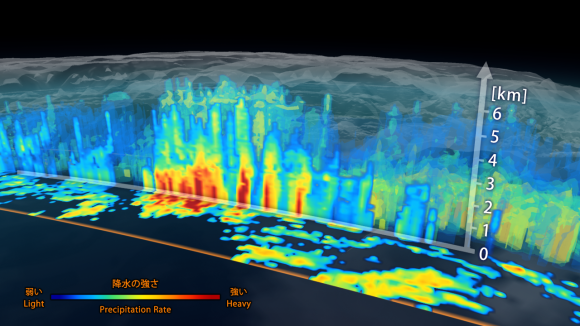
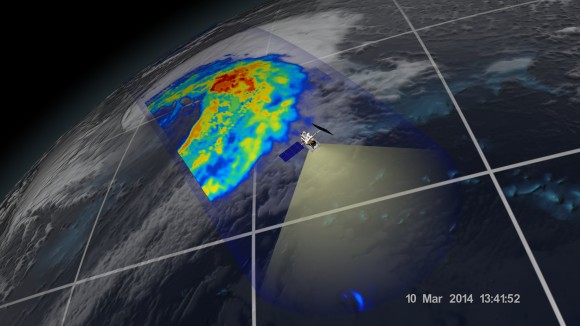
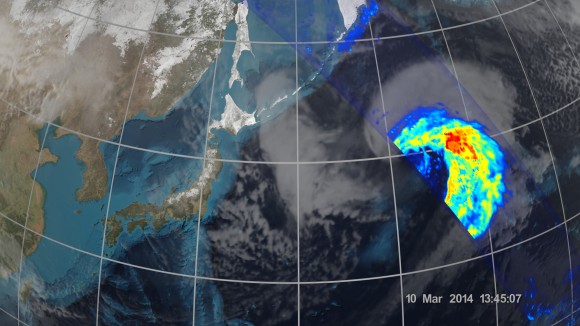
Possession Island, East Island, and cloud patterns
Water Detected on Dwarf Planet Ceres
Latest Thermometer readings at Gale crater (winter)-> -29 c / -114 c (Colder than Earth winters ?) .. wind speeds around 10 kmph ..
The corresponding EET (Earth Equivalent Temperatures) - > -4 c / -28 c ..
This feels like Inner Mongolia /Xinjiang/ Qinghai (all China provinces) winters ..
A)Because of rarified atmosphere on Mars transfer of heat by convection is feeble..
B)Also a Martian wind speed of 100 kmph might feel like a breeze of 10 kmph because Mars is almost vacuum ( 1% air pressure of Earth)..
Wet Asteroid’s Remains Found In Old Star That Could Have Hosted Habitable Planets
Astrophoto: Aurora Dancing on the Water
Big Bang’s Sound-Like Waves Show Up In Lab Simulation
Tracing back to the Big Bang. Image credit: Ivo Labbé
An ultracold vacuum chamber ran a simulation of the early universe and came up with some interesting findings about how the environment looked shortly after the Big Bang occurred.
http://www.youtube.com/watch?feature=player_embedded&v=E7PQbfnErEw
Venus’ Winds Are Mysteriously Speeding Up to....
Read more: http://www.universetoday.com/102616/our-place-in-the-galactic-neighborhood-just-got-an-upgrade/#ixzz2VGvpSkoR
Visibility will improve in the nights ahead as the comet moves away from the sun. Dates of special interest include March 12th and 13th when Pan-STARRS passes not far from the crescent Moon. The tight conjunction on the 12th provides a splendid opportunity for sunset photographers.
“Gale Crater may look like the dusty, basaltic basins of the American southwest, but one look at the thermometer will send you running for the winter coat.”
– Jeffrey Marlow, Martian Diaries
This fantastic images that are being returned from NASA’s Curiosity rover show a rocky, ruddy landscape that could easily be mistaken for an arid region of the American Southwest one must remember three things: this is Mars, we’re looking around the inside of an impact crater billions of years old, and it’s cold out there.
Over the first 30 sols, air temperature has ranged from approximately -103 degrees Fahrenheit (-75 Celsius) at night to roughly 32 degrees Fahrenheit (0 Celsius) in the afternoon. Two factors conspire to cause such a wide daily range (most day-night fluctuations on Earth are about 10 to 30 degrees Fahrenheit). The martian atmosphere is very thin; with fewer molecules in the air to heat up and cool down, there’s more solar power to go around during the day, and less atmospheric warmth at night, so the magnitude of temperature shifts is amplified. There is also very little water vapor; water is particularly good at retaining its heat, and the dryness makes the temperature swings even more pronounced.
In that way Mars is like an Earthly desert; even after a blisteringly hot day the temperatures can plummet at night, leaving an ill-prepared camper shivering beneath the cold glow of starlight. Except on Mars, where the Sun is only 50% as bright as on Earth and the atmosphere only 1% as dense, the nighttime lows dip to Arctic depths.
“Deserts on Earth have very extreme temperature ranges,” says Mars Science Laboratory Deputy Project Scientist, Ashwin Vasavada. “So if you take a desert on Earth and put it in a very thin atmosphere 50% farther from the Sun, you’d have something like what we’re seeing at Gale Crater.”
And although the afternoon temperatures in Gale may climb slightly above freezing that doesn’t mean liquid water will be found pooling about in any large amounts. Curiosity’s in no danger from flash floods on Mars… not these days, anyway.
With atmospheric pressure just above water’s thermodynamic triple point, and temperatures occasionally hovering around the freezing point, it is likely that local niches are seeing above-zero temperatures, and Vasavada acknowledges, “liquid water could exist here over a tiny range of conditions.
“We wouldn’t expect for Curiosity to see liquid water, because it would evaporate or re-freeze too quickly,” explains Vasavada. “With so little water vapor in the atmosphere, any liquid water molecules on the surface would quickly turn to gas.”
 Observations by NASA’s Mars Reconnaissance Orbiter have detected carbon-dioxide snow clouds on Mars and evidence of carbon-dioxide snow falling to the surface. Image credit: NASA/JPL-Caltech
Observations by NASA’s Mars Reconnaissance Orbiter have detected carbon-dioxide snow clouds on Mars and evidence of carbon-dioxide snow falling to the surface. Image credit: NASA/JPL-Caltech In 2008, we learned from the Phoenix Mars lander that it snows in Mars northern hemisphere — perhaps quite regularly – from clouds made of water vapor.
Now,Mars Reconnaissance Orbiter data has revealed the clearest evidence yet of carbon-dioxide snowfalls on Mars. Scientists say this is the only known example of carbon-dioxide snow falling anywhere in our solar system.
“These are the first definitive detections of carbon-dioxide snow clouds,” said Paul Hayne from the Jet Propulsion Laboratory, lead author of a new study published in the Journal of Geophysical Research. “We firmly establish the clouds are composed of carbon dioxide — flakes of Martian air — and they are thick enough to result in snowfall accumulation at the surface.”
Scientists have known for decades that carbon-dioxide exists ice in Mars’ seasonal and permanent southern polar caps. Frozen carbon dioxide, sometimes called “dry ice” here on Earth, requires temperatures of about -125 Celsius ( – 193 degrees Fahrenheit), which is much colder than needed for freezing water.
The data provide information about temperatures, particle sizes and their concentrations. The new analysis is based on data from observations in the south polar region during southern Mars winter in 2006-2007, identifying a tall carbon-dioxide cloud about 500 kilometers (300 miles) in diameter persisting over the pole and smaller, shorter-lived, lower-altitude carbon dioxide ice clouds at latitudes from 70 to 80 degrees south.
“One line of evidence for snow is that the carbon-dioxide ice particles in the clouds are large enough to fall to the ground during the lifespan of the clouds,” co-author David Kass of JPL said. “Another comes from observations when the instrument is pointed toward the horizon, instead of down at the surface. The infrared spectra signature of the clouds viewed from this angle is clearly carbon-dioxide ice particles and they extend to the surface. By observing this way, the Mars Climate Sounder is able to distinguish the particles in the atmosphere from the dry ice on the surface.”
Mars’ south polar residual ice cap is the only place on the Red Planet where frozen carbon dioxide persists on the surface year-round. Just how the carbon dioxide from Mars’ atmosphere gets deposited has been in question. It is unclear whether it occurs as snow or by freezing out at ground level as frost. These results show snowfall is especially vigorous on top of the residual cap.
“The finding of snowfall could mean that the type of deposition — snow or frost — is somehow linked to the year-to-year preservation of the residual cap,” Hayne said.
by Nancy Atkinson. Source Universe Today.
Image Caption: Rover’s Self Portrait -This Picasso-like self portrait of NASA’s Curiosity rover was taken by its Navigation cameras, located on the now-upright mast. The camera snapped pictures 360-degrees around the rover, while pointing down at the rover deck, up and straight ahead. Those images are shown here in a polar projection. Most of the tiles are thumbnails, or small copies of the full-resolution images that have not been sent back to Earth yet. Two of the tiles are full-resolution. Credit: NASA/JPL-Caltech.
Taken this morning (mission Sol 2) with the rover’s left Navcam, here’s a high-res panorama of Curiosity’s view at its landing site within Gale crater. The wide-angle view was assembled from two separate raw images, so while the mountainous rim of the crater is lined up horizontally there’s some distortion in alignment of objects closer to the rover due to the angle of the Navcam lens. Still, it’s a very cool view of Curiosity’s surroundings!
Image: NASA/JPL-Caltech
Huge Dust Devil on Mars Captured in Action..by NANCY ATKINSON -Universe Today.
Opportunity investigates Tisdale 2 rock showing indications of ancient Martian water flow
NASA's Mars Exploration Rover Opportunity used its front hazard-avoidance camera to take this picture showing the rover's arm extended toward a light-toned rock, "Tisdale 2," during Sol 2695 of the rover's work on Mars (Aug. 23, 2011). The composition of Tisdale 2 is unlike any rock studied by Opportunity since landing 7.5 years ago. It is about 12 inches (30 centimeters) tall. Credit: NASA/JPL-Caltech
Scientists directing NASA’s Mars Opportunity rover gushed with excitement as they announced that the aging robot has discovered a rock with a composition unlike anything previously explored on the Red Planet’s surface – since she landed on the exotic Martian plains 7.5 years ago – and which offers indications that liquid water might have percolated or flowed at this spot billions of years ago.
Look east about a half hour before sunrise. If you have a clear view of the horizon, you'll see Mercury, Venus, Mars and Jupiter clustered together in a patch of sky less than 10o wide. The view is too good.
The best morning is May 11th, when Venus and Jupiter converge to form a tight pair only 1/2o apart. Venus and Jupiter are so bright you might think you've witnessed a double supernova beaming through the morning twilight. But, no, it's just the two brightest planets in our own solar system.
Keep an eye on Venus in particular. As the sun rises and the sky fills with morning blue, the Goddess of Love does not fade away. You can actually see Venus in broad daylight if you know where to look.
May 11th is just the beginning. Throughout the month, the quartet of worlds will rearrange themselves on a daily basis, forming different shapes in the pre-dawn sky.
On May 13th, for instance, Mercury, Venus and Jupiter form a bright celestial triangle--almost equilateral. It's a geometry lesson before breakfast. On May 20th, a new triangle will appear. This time the vertices are Mars, Venus, and Mercury.
Observing tip: Mars is not as bright as the others. Binoculars may be required to help you find and fully appreciate the red planet in morning twilight.
Credit: Science@NASA
The Great Moon Hoax of 1835
On April 12, 1961, Russian cosmonaut Yuri Gagarin (left, on the way to the launch pad) became the first human in space, making a 108-minute orbital flight in his Vostok 1 spacecraft.
Newspapers like The Huntsville Times (right) trumpeted Gagarin's accomplishment.
Credit: NASA
From Anne Minard
UPDATE, 9:50 p.m. EDT: NASA has abandoned all its cautionary language. MESSENGER is confirmed in orbit!
MESSENGER — which stands for MErcury Surface, Space ENvironment, GEochemistry and Ranging — launched Aug. 3, 2004 from Cape Canaveral. The orbit insertion places the spacecraft into a 12-hour orbit about Mercury with a 200 kilometer (124 mile) minimum altitude. The durable spacecraft is carrying seven science instruments and is fortified against the blistering environs near the sun.
The mission is an effort to study the geologic history, magnetic field, surface composition and other mysteries of the planet. The findings are expected to broaden our understanding of rocky planets, more and more of which are being discovered in other solar systems. One of the most compelling enigmas surrounds Mercury’s magnetic field. At a diameter only slightly larger than that of the moon (about 4,800 kilometers or 2,983 miles), Mercury should have solidified to the core. However, the presence of a magnetic field suggests to some researchers that the planet’s insides could be partially molten.
During its journey toward Mercury, MESSENGER passed the planet several times, filling in the imaging gaps left by Mariner 10. Now, the entire planet with the exception of about five percent has been observed. MESSENGER will focus its cameras on getting the best possible images of the remaining portions, mostly in the polar regions.
Source: NASA’s MESSENGER mission website and NASA TV.
Thundersto
“It is humbling, said Paul Geissler, lead author on eolian — or wind — processes on Mars. “We make kilometer-long human graffiti on the surface of another planet and then Mars just wipes the slate clean for the next visitors!”
Posted on 28th. November:
With the Sun‘s activity increasing just a bit, sky watchers have witnessed an uptick in aurorae, especially northern observers. This top image is from an *extreme* northern observer, as in way up; about 320 km (220 miles) up above the Earth.
A recent aurora as seen by astronaut Doug Wheelock on the International Space Station. Credit: NASA
Astronaut Doug Wheelock took this image from the International Space Station, and the beautiful sight made him wax poetic:
“Aurora Borealis as I will forever paint it in my dreams,” he wrote on Twitter. “Almost time to return home… no regrets… but mixed emotions. Leonardo da Vinci was right… ‘For once you have tasted flight, you will forever walk the Earth with your eyes turned skyward, for there you have been… and there you will long to return.’”
Colorful Clouds, taken on Nov. 14, 2010 by Ole C. Salomonsen in Tromsø, Norway. Used by permission.
Describing this picture, Salomonsen said on Flickr: “With a CME expected to hit earth on Nov.14th we could still see only a faint aurora. We got frustrated and then decided to drive back towards the city where it now was reported to clear up. After 5 minutes in the car suddenly we could see a strong aurora bursting out behind the partially cloudy sky.”
Aurora over Tromsø, Norway, November 14, 2010. Credit: Ole C. Salomonsen. Used by permission
This is another gorgeous shot by Salomonsen, and on his Flickr site, he points out Ursa Major is visible in the top left, said it was just amazing how there were two rays of white and purple aurora, one moving faster than the other.
Posted on 10th. November:
A solar prominence is observed using photons at wavelength 304 Å. Credit: European Space Agency (ESA) and NASA.
Posted on 29th. October:
Clouds on Titan seen by the Cassini spacecraft on Sept. 27. 2010. Credit: NASA/JPL/Space Science Institute
The Cassini spacecraft recently swooped by Saturn’s largest moon Titan and captured images of large patches of clouds. “These are some of the largest clouds our cameras on Cassini have yet seen on Titan!” said Carolyn Porco, Cassini imaging team lead, in an email announcing the image. “And the fact that we see them in the equatorial region is big news and may signify seasonal change is underway!”
The image was taken on September 27, 2010 and received on Earth September 28, 2010 at a distance of approximately 1,282,259 kilometers away. The spacecraft was actually at its closest approach on Sept. 24, and took a long, sustained look at the hazy moon, coming within 8,175 kilometers (5,080 miles) above the hazy moon’s surface.
Posted on 16th.October:
Marsquake causes landslide ??
McEwen,principal investigator of HiRISE, said the landslide could have been triggered by a Marsquake or a small impact event.”
Thanks to the Mars Reconnaisance Orbiter and the on-board HiRISE camera, scientists are able to monitor Mars for changes taking place on the landscape. They do this by comparing older images with newer ones, and also by seeing “fresh” features — like this recent landslide in Zunil Crater. “The color and albedo patterns indicate that a landslide occurred here very recently–too recently to have been re-covered by dust,” writes Alfred McEwen, writing on the camera’s website. “Looking for changes such as this will help us to better understand active processes.”
The fact that landslides have occurred here indicates that the valley walls are not stable and the materials respond to Martian gravity with mass movements.”
Discussion among other image artists on UnmannedSpaceflight.com indicated that the blue areas could easily be patches of ice deposited from the cliff face. You can see the original image at the HiRISE website.
Credit: NASA/JPL/University of Arizona
Posted on 12th. October:
GEOMAGNETIC STORM: On Oct. 11th, the interplanetary magnetic field (IMF) near Earth tilted south, opening a crack in Earth's magnetosphere. Solar wind poured in and fueled a geomagnetic storm around the Arctic Circle. Beautiful Auroras were seen due to this natural phenomena.
 Christian Schartner sends this picture (courtesy spaceweather.com) from Senja, Norway: "The lights were so bright, changing the lens on my camera was no problem!"
Christian Schartner sends this picture (courtesy spaceweather.com) from Senja, Norway: "The lights were so bright, changing the lens on my camera was no problem!"At its peak, the storm registered 5 on the 0-to-9 K-index scale of geomagnetic disturbances. On a global scale such storms are considered "mild," but at high latitudes some of the views were undeniably intense.
For a good report on this, read on at Akshay's blog here
Posted on 10th. October:
Credits: ESA/DLR/FU Berlin (G. Neukum)
Melas Chasma cuts into the middle of Mars surface, making it an interesting place: there is abundant evidence for water having flowed here, with ancient water-cut channels visible even from orbit. Also visible are landslides that have created huge fans of rubble at the base of the cliffs. These newest images from ESA’s Mars Express show Melas Chasma, which sinks 9 km below the surrounding surface, making it one of the lowest depressions on the planet. This is just a small part of the bigger Valles Marineris, which stretches for more than 4,000 km across the surface of Mars.
Posted on 7th. October:
Image credit: NASA/JPL/SSI and NASA/JPL/University of Arizona
On the left, Saturn's moon Enceladus is backlit by the sun, showing the fountain-like sources of the fine spray of material that towers over the south polar region. On the right, is a composite image of Titan.
The Cassini spacecraft has performed close flybys of two of Saturn's most enigmatic moons all within less than 48 hours, and with no maneuvers in between. Enceladus and Titan are aligned just right so that Cassini can catch glimpses of these two contrasting moons – one a geyser world and the other an analog to early Earth.
On to Titan: The spacecraft went to within 1,400 kilometers (750 miles) of the surface.
Cassini will primarily be doing radio science during this pass to detect the subtle variations in the gravitational tug on the spacecraft by Titan, which is 25 percent larger in volume than the planet Mercury. Analyzing the data will help scientists learn whether Titan has a liquid ocean under its surface and get a better picture of its internal structure. The composite infrared spectrometer will also get its southernmost pass for thermal data to fill out its temperature map of the smoggy moon.
Titan is Saturn’s largest moon, and the second largest moon in the Solar System. It’s unique in the Solar System as the only moon with an atmosphere. In fact, scientists think that Titan’s thick atmosphere – rich in hydrocarbons – is similar to the early Earth, and could give us clues about how life got started on our planet.
Source: NASA JPL/spaceweather.
Posted on 28th.September:
Left: T43 flyby of Titan - 12 May 2008 – VIMS images a large cloud that caps the north pole of Titan (yellowish tones). Right: T63 flyby of Titan - 12 December 2009 – VIMS still observes a huge cloud system at 40°S (yellowish tones) and the north pole of Titan free of clouds, a few months after the equinox. Credit: NASA/JPL/University of Arizona/University of Nantes/ University of Paris Diderot.
Titan Weather Report for Spring: Still Cold, but Clearing Skies
The Cassini spacecraft‘s Visual and Infrared Mapping Spectrometer (VIMS) instrument has been monitoring clouds on Titan continuously since the spacecraft went into orbit around Saturn in 2004, and a team led by Sébastien Rodriguez (AIM laboratory – Université Paris Diderot) has used more than 2,000 VIMS images to create the first long-term study of Titan’s weather.
In its 30-years orbit around the Sun, Titan has seasons that last for 7 terrestrial years. The team has observed significant atmospheric changes between July 2004 (early summer in the southern hemisphere) and April 2010, the very start of northern spring. The images showed that cloud activity has recently decreased near both of Titan’s poles. These regions had been heavily overcast during the late southern summer until 2008, a few months before the equinox.
The team has used results from the Global Climate Models (GCMs) developed by Pascal Rannou (Institut Pierre Simon Laplace) to interpret the evolution of the observed cloud patterns over time. Northern polar clouds of ethane form in the Titan’s troposphere during the winter at altitudes of 30-50 km by a constant influx of ethane and aerosols from the stratosphere. In the other hemisphere, mid- and high-latitudes clouds are produced by the upwelling from the surface of air enriched in methane. Observations of the location and activity of Titan’s clouds over long periods are vital in developing a global understanding of Titan’s climate and meteorological cycle.
Are they ready to make a weather forecast? They say Titan’s northern hemisphere is set for mainly fine spring weather, with polar skies clearing since the equinox in August last year.
Source: European Planetary Science Conference.
Posted on 23rd.September
Artists impression of lightning storms on Venus. Credit: ESA
Lightning Storms on Venus Similar to Those On Earth
Venus is a world not for the faint of heart. On its surface you’d have to endure high temperatures and intense air pressures, plus within the thick, sulfuric acid-laced atmosphere there are actually lightning storms.
These storms are surprisingly similar to lightning storms on Earth, despite the great differences between the atmospheres of the two planets. “Venus and Earth are often called twin planets because of their similar size, mass, and interior structure,” said Dr. Christopher Russell from the University of California, “The generation of lightning is one more way in which Venus and Earth are fraternal twins.”
Scientists have known there was lightning on Venus since the early planetary missions such as the Venera and Pioneer Venus Orbiter missions, and more recently the Galileo spacecraft reported evidence for optical and electromagnetic waves from Venus that could be produced by lightning. This was also confirmed by ground telescopes capturing lighting flashes at Venus.
Now, the Venus Express spacecraft, in orbit around Venus, has been studying Venus’ lightning in detail with its magnetometer, at altitudes between 200 and 500 km.
When clouds form, on Earth or Venus, the energy that the Sun has deposited in the air can be released in a very powerful electrical discharge. As cloud particles collide, they transfer electrical charge from large particles to small, and the large particles fall while the small particles are carried upward. The separation of charges leads to lightning strokes. This process is important for a planetary atmosphere because it raises the temperature and pressure of a small portion of the atmosphere to a very high value so that molecules can form, which would not otherwise occur at standard atmospheric temperatures and pressures.
“We have analyzed 3.5 Earth-years of Venus lightning data using the low-altitude Venus Express data, which is about 10 minutes per day,” Russell said. “By comparing the electromagnetic waves produced at the two planets, we found stronger magnetic signals on Venus, but when converted to energy flux we found very similar lightening strength,” said Russell. Also it seems that lightning is more prevalent on the dayside than at night, and happens more often at low Venusian latitudes where the solar input to the atmosphere is strongest.”
Source: European Planetary Science Congress
Sunday, 19th.September 2010:
Look! Up in the sky! “Jupiter is making its closest pass by Earth for the year. And this year’s pass is a little closer than any other between 1963 and 2022.”
Where do you find Jupiter? Try about 368 million miles away and (for most observers) low to the southeast after the skies get dark. The giant planet will reach its nearest point to us on the evening of September 20, 2010 – but will remain one of the brightest objects in the night through the end of the month.
Why does Jupiter appear to be more luminous now than at any other time? Although the varying distances over the years may seem marginal – about 10 to 11 million miles over a period of around 60 years – it translates into significance when it comes to magnitude factors. At its brightest, Jupiter can reach –2.94, and dimmest at -1.6. Just a 1% distance change can mean either 4% brighter or dimmer!
The mighty Jove has also undergone some cosmetic changes in the past year as well, making it an additional 4% brighter than usual.
Of course, a close pass doesn’t mean Jupiter is going to appear to be the size of the Moon – nor be as bright – but it’s certainly going to make a grand appearance on the nights of September 22 and September 23 .
Such a view was recently beamed back by
NASA’s Mercury Surface, Space Environment, Geochemistry, and Ranging (MESSENGER) spacecraft.
Looking back from its orbit around Mercury, MESSENGER captured this view of Earth and the Moon on May 6, 2010. The spacecraft was 183 million kilometers (114 million miles) from Earth at the time, farther than our average distance from the Sun (150 million kilometers, or 93 million miles) because Mercury and Earth were at different places in their orbits around the Sun.
MESSENGER is the first spacecraft to orbit Mercury since Mariner 10 in 1974-75.
Source: NASA JPL
Thursday, 16th. September.

 .
.
